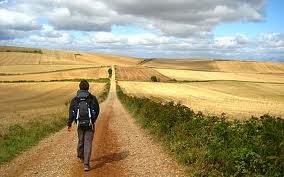Expected later: a mix of sun and clouds and the temperature pretty much staying the same throughout the day
The past couple of weeks, one of our favorite shows, Grey's Anatomy, has been coming on early on Wednesday night. With Lloyd gone to bed by 7:00, Brenda would come over after and we would open up a bottle of wine, get our chosen snacks for the evening and park ourselves in front of the TV from 8:00 till 9:00. Now, just when we've gotten our routine established, it's off the air until the 29th of January. Seriously??? Now we have to go through the whole process again of finding a great excuse to meet up and indulge just a little. No worries, though, as I'm sure we'll come up with something to get us through the next couple of months and a cold, snowy winter.
I've been diligently working on my community school project. We have one class left and I'm a long way from being finished. So I've come up with a brilliant plan. I spend my lunch hours upstairs at work, in the boardroom. I have a lovely large table and quiet space all to myself. I take my lunch and eat it as I work, and at the same time, I watch something on my ipad. It's working out quite nicely for me. Gives me something to do at lunch without going outside in the cold!
Have I mentioned the Camino de Santiago? I first learned about it a couple of years ago and have seen a 
movie and a documentary about it. Then recently a woman came to community school to share her experience walking the route, by herself, at the age of 67. How inspiring it that? So I've done a tiny bit of research and have lots more to do, but I would really like to do this roughly 800 km walk, across part of France and Spain, sometime in the next 2 or 3 years. The lady we spoke with told us it took her 5 weeks to complete. I'd love to do it sooner, rather than later but fear that job commitments would never allow me to take that much time off at once. I may just have to wait until I turn 65 and am retired but we'll see. Obviously I need to do a a 
The Camino de Santiago or the Way of St. James is a spiritual journey that pilgrims of all faiths and
backgrounds have traversed for over a thousand years. The pilgrimage originally began at one’s doorstep, though modern trekkers today would find that rather difficult, particularly American pilgrims needing to cross the Atlantic. While there are a number of established routes leading to Santiago from all directions, the most popular is the Camino Frances, which crosses the Pyrenees Mountains along the Spanish-French border starting in St. Jean Pied de Port.
This Camino route covers 800 kilometers that traverses an idyllic northern Spanish countryside. By
following the yellow painted arrows marking the road, a pilgrim can expect to walk 12-15 miles a day to reach the next town for the night. At this pace, a pilgrim can reach the Cathedral de Santiago in 6 to 8 weeks time to attend the Pilgrim's Mass held at noon each day. Some take more time, others less.
Some choose to travel by bike, and some have done the Camino on horseback. Along the way travelers encounter albergues, refugios and casa rurals that cater specifically to the thousands of pilgrims of all ages that take this journey each year,
immersing themselves in the local food, culture and history dedicated to this experience.
Pilgrims walk the Camino for various reasons. Some to seek penance, others enlightenment, and still others for a sense of adventure, yet all progress toward the Cathedral in Santiago where it is believed the remains of the apostle St. James are held.
Most pilgrims choose to carry a scallop shell with them to symbolize their journey in honor of St. James. According to legend, scallop shells are said the have covered St. James’ body after it was found on the shores of the Galician coast. Another, perhaps more useful symbol is a walking stick to aid a weary pilgrim on his or her journey.
Most pilgrims also carry a document called the credencial, purchased for a few euros from a Spanish tourist agency, a church on the route or from their church back home. The credencial is a pass which gives access to inexpensive, sometimes free, overnight accommodation in refugios along the trail. Also known as the "pilgrim's passport", the credencial is stamped with the official St. James stamp of each town or refugio at which the pilgrim has stayed. It provides walking pilgrims with a record of where they ate or slept, but also serves as proof to the Pilgrim's Office in Santiago that the journey is accomplished according to an official route. The credencial is available at refugios, tourist offices, some local parish houses, and outside Spain, through the national St. James organisation of that country. The stamped credencial is also necessary if the pilgrim wants to obtain a compostela, a certificate of completion of the pilgrimage.
Regardless of whether a pilgrim’s journey begins for religious, spiritual or cultural reasons, the meditative nature of the Camino offers the perfect landscape in which to dedicate contemplation. Pilgrims follow the path amidst the villages, towns, rivers, mountains and fertile valleys that have changed the lives of millions of pilgrims who walked before them.
This will be a huge undertaking and will require a lot of preparation, but I really want to have this experience. It's very high on my bucket list!




No comments:
Post a Comment